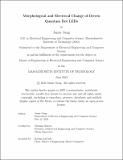| dc.contributor.advisor | Bulović, Vladimir | |
| dc.contributor.author | Geng, Jamie | |
| dc.date.accessioned | 2023-07-31T19:40:56Z | |
| dc.date.available | 2023-07-31T19:40:56Z | |
| dc.date.issued | 2023-06 | |
| dc.date.submitted | 2023-06-06T16:35:37.645Z | |
| dc.identifier.uri | https://hdl.handle.net/1721.1/151453 | |
| dc.description.abstract | Quantum dot LEDs (QD-LEDs) are an emerging technology that promises brighter, more color pure, higher-color gamut displays. In recent years, indium phosphidenquantum dots have become the one of the most promising device emitters due to their lower toxicity. However, InP QD-LED devices require further development, especially in the area of long-term stability, to be viable on the market.
In this thesis, we present an exploration of degradation mechanisms via device cross-sectioning and TEM analysis. We show that quantum dots in QD-LEDs coarsen and oxidize upon driving by measuring space-resolved chemical composition and bandgap. We validate that this manifests electrically as increased resistance. Additionally, we studied hydrogen doping of the ZnMgO electron transport layer, which is known to improve QD-LEDs during operation. We performed in-situ TEM to simultaneously hydrogen dope and image drop-cast ZnMgO nanoparticles, and show that they coarsen through this process. | |
| dc.publisher | Massachusetts Institute of Technology | |
| dc.rights | In Copyright - Educational Use Permitted | |
| dc.rights | Copyright retained by author(s) | |
| dc.rights.uri | https://rightsstatements.org/page/InC-EDU/1.0/ | |
| dc.title | Morphological and Electrical Change of Driven Quantum Dot LEDs | |
| dc.type | Thesis | |
| dc.description.degree | M.Eng. | |
| dc.contributor.department | Massachusetts Institute of Technology. Department of Electrical Engineering and Computer Science | |
| mit.thesis.degree | Master | |
| thesis.degree.name | Master of Engineering in Electrical Engineering and Computer Science | |
